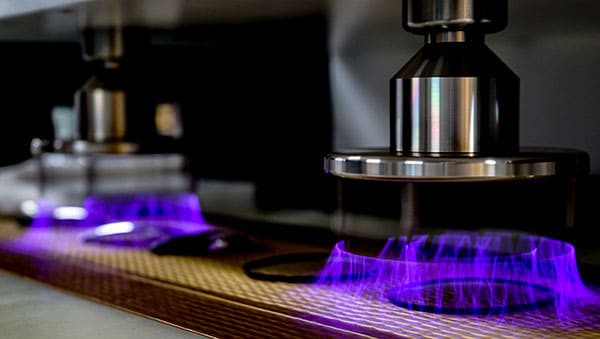Corona Can Improve the Production Process of Plastic Lenses
Plastic materials for ophthalmic lenses have seen continual developments, and for this reason, have gradually replaced glass materials. Today, most corrective lenses are made of thermoplastic and thermosetting resins. The success of plastic lenses is growing even more due to technical breakthroughs enabling lenses to be thinner and lighter, and a greatly increase of their impact resistance by using sophisticated treatment and coating methods.
Since plastics are composed of non-polar, long-chain molecules, their surfaces have little free energy, and are essentially inert. The low surface energies of plastics thus pose adhesion and wettability problems for lens manufacturers. Corona treatment plays an important role to promote better adhesion properties by changing the surface characteristics, breaking the molecular bonds on the substrate surface. This increases surface energy and thereby the surface wet ability without affecting the optical properties.

Tantec Surface Treatment prior to Cleaning and Coating
Ophthalmic plastic lenses are sophisticated products, and their performance rely very much on the surface treatments they are undergoing in the manufacturing process prior to applying i.e., tinted, photochromism or hard coatings.
In conjunction with some of the world’s leading lens manufacturers, Tantec A/S, Denmark, has developed Corona treaters to improve quality and productivity of optical lens manufacturing. The new in-line Corona treaters are now making the labour intensive batch pre-treatment very ineffective.
Tantec’s RotoTEC-X units are in-line o-ring belt conveyors with an integrated rotary electrode system to ensure an extreme uniform Corona-discharge distribution on the optical surfaces. Surface tensions as high as water wet ability (72mN/m) are achieved, which makes a RotoTEC-X-unit indispensable prior to the washing of the lenses. As the water spreads evenly on the surface, an ultra-clean surface is presented to the following coating processes.
After washing and drying, the Corona treatment effect is more or less gone, therefore, the lenses are passing through a second RotoTEC-X unit on the line to re-establish high surface tension before the first coating process. A third RotoTEC-X is required downstream, if a further layer of coating is prescribed i.e, photochromic or hard coatings.
A Tantec RotoTEC-X is available as a single- or double lane o-ring conveyor with an open front design for easy access and quick exchange of endless transport belts. All belts are changed within 3-5 minutes without disassembling any machine parts.
Tantec is a pioneer of developing equipment for surface treatment of plastic components such as ophthalmic lenses. Our object is to solve adhesion problems for the industry, offering a unique surface treatment method to ensure a safe and clean global environment.
Tantec offers standard and customized equipment to be integrated as a part of the production process, and can be integrated in new or existing on-line production environments.
